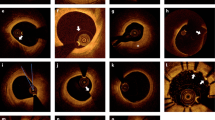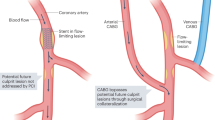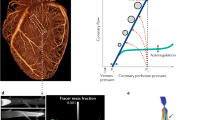Abstract
The practice of clinical cardiology employs many imaging techniques for diagnosis, risk stratification and therapeutic monitoring. These imaging modalities largely provide anatomical or structural information, and only indirectly reflect underlying molecular events. Molecular imaging techniques report on entities or processes that can be defined at the molecular, as opposed to the anatomical, level. For example, molecular imaging can reveal the expression or activity of a specific protein, the fate or localization of a biomolecule, or the activity of a biological pathway. This Review highlights key processes and molecular targets that are currently being investigated experimentally by molecular imaging probes in vivo. Collectively, these targets have an important role in the development of atherosclerosis and acute plaque rupture, as well as in myocardial disease. Molecular imaging technology is now progressing towards clinical application in humans and has the potential to guide diagnosis, risk assessment and treatment response. Imaging-based surrogate end points could speed the development of new drugs, particularly those with novel mechanisms of action. More broadly, by noninvasively reporting on molecular processes in vivo, molecular imaging can reveal how specific proteins or pathways function in their native context, thus contributing to a systems-level understanding of cardiovascular disease biology.
Key Points
-
The imaging techniques currently used in clinical cardiology predominantly provide structural or anatomical information
-
Molecular imaging probes report on the expression or activity of proteins, biological pathways or cells, such as apoptosis, thrombus formation or stabilization, and cellular metabolism
-
Molecular imaging targets can be engaged by antibodies, peptides, aptamers, or small molecules
-
Existing molecular imaging probes have been widely tested in murine or large-animal models of atherosclerosis or myocardial disease; a small number of probes are being investigated in human trials
-
Unbiased screens for novel imaging probes with no prespecified target could facilitate the discovery of novel imaging agents and targets
-
Targeted molecular imaging probes can contribute to phenotyping of patients, drug development, translational studies, and a systems-level view of cardiovascular disease
This is a preview of subscription content, access via your institution
Access options
Subscribe to this journal
Receive 12 print issues and online access
$209.00 per year
only $17.42 per issue
Buy this article
- Purchase on Springer Link
- Instant access to full article PDF
Prices may be subject to local taxes which are calculated during checkout







Similar content being viewed by others
References
Libby, P. Inflammation in atherosclerosis. Nature 420, 868–874 (2002).
Fuster, V., Moreno, P. R., Fayad, Z. A., Corti, R. & Badimon, J. J. Atherothrombosis and high-risk plaque: part I: evolving concepts. J. Am. Coll. Cardiol. 46, 937–954 (2005).
Lipinski, M. J., Fuster, V., Fisher, E. A. & Fayad, Z. A. Technology insight: targeting of biological molecules for evaluation of high-risk atherosclerotic plaques with magnetic resonance imaging. Nat. Clin. Pract. Cardiovasc. Med. 1, 48–55 (2004).
Sosnovik, D. E., Nahrendorf, M. & Weissleder, R. Targeted imaging of myocardial damage. Nat. Clin. Pract. Cardiovasc. Med. 5 (Suppl. 2), S63–S70 (2008).
Cybulsky, M. I. et al. A major role for VCAM-1, but not ICAM-1, in early atherosclerosis. J. Clin. Invest. 107, 1255–1262 (2001).
Kaufmann, B. A. et al. Molecular imaging of inflammation in atherosclerosis with targeted ultrasound detection of vascular cell adhesion molecule-1. Circulation 116, 276–284 (2007).
Nahrendorf, M. et al. Noninvasive vascular cell adhesion molecule-1 imaging identifies inflammatory activation of cells in atherosclerosis. Circulation 114, 1504–1511 (2006).
McAteer, M. A. et al. In vivo magnetic resonance imaging of acute brain inflammation using microparticles of iron oxide. Nat. Med. 13, 1253–1258 (2007).
de Winther, M. P., van Dijk, K. W., Havekes, L. M. & Hofker, M. H. Macrophage scavenger receptor class A: a multifunctional receptor in atherosclerosis. Arterioscler. Thromb. Vasc. Biol. 20, 290–297 (2000).
Lipinski, M. J. et al. MRI to detect atherosclerosis with gadolinium-containing immunomicelles targeting the macrophage scavenger receptor. Magn. Reson. Med. 56, 601–610 (2006).
Amirbekian, V. et al. Detecting and assessing macrophages in vivo to evaluate atherosclerosis noninvasively using molecular MRI. Proc. Natl Acad. Sci. USA 104, 961–966 (2007).
Mulder, W. J. et al. Molecular imaging of macrophages in atherosclerotic plaques using bimodal PEG-micelles. Magn. Reson. Med. 58, 1164–1170 (2007).
Tsimikas, S., Shortal, B. P., Witztum, J. L. & Palinski, W. In vivo uptake of radiolabeled MDA2, an oxidation-specific monoclonal antibody, provides an accurate measure of atherosclerotic lesions rich in oxidized LDL and is highly sensitive to their regression. Arterioscler. Thromb. Vasc. Biol. 20, 689–697 (2000).
Briley-Saebo, K. C. et al. Targeted molecular probes for imaging atherosclerotic lesions with magnetic resonance using antibodies that recognize oxidation-specific epitopes. Circulation 117, 3206–3215 (2008).
Weissleder, R. et al. Ultrasmall superparamagnetic iron oxide: characterization of a new class of contrast agents for MR imaging. Radiology 175, 489–493 (1990).
Ruehm, S. G., Corot, C., Vogt, P., Kolb, S. & Debatin, J. F. Magnetic resonance imaging of atherosclerotic plaque with ultrasmall superparamagnetic particles of iron oxide in hyperlipidemic rabbits. Circulation 103, 415–422 (2001).
Nahrendorf, M. et al. Nanoparticle PET-CT imaging of macrophages in inflammatory atherosclerosis. Circulation 117, 379–387 (2008).
Kooi, M. E. et al. Accumulation of ultrasmall superparamagnetic particles of iron oxide in human atherosclerotic plaques can be detected by in vivo magnetic resonance imaging. Circulation 107, 2453–2458 (2003).
Harisinghani, M. G. et al. Noninvasive detection of clinically occult lymph-node metastases in prostate cancer. N. Engl. J. Med. 348, 2491–2499 (2003).
Jones, C. B., Sane, D. C. & Herrington, D. M. Matrix metalloproteinases: a review of their structure and role in acute coronary syndrome. Cardiovasc. Res. 59, 812–823 (2003).
Garcia-Touchard, A. et al. Extracellular proteases in atherosclerosis and restenosis. Arterioscler. Thromb. Vasc. Biol. 25, 1119–1127 (2005).
Schäfers, M. et al. Scintigraphic imaging of matrix metalloproteinase activity in the arterial wall in vivo. Circulation 109, 2554–2559 (2004).
Su, H. et al. Noninvasive targeted imaging of matrix metalloproteinase activation in a murine model of postinfarction remodeling. Circulation 112, 3157–3167 (2005).
Breyholz, H. J. et al. A 18F-radiolabeled analogue of CGS 27023A as a potential agent for assessment of matrix-metalloproteinase activity in vivo. Q. J. Nucl. Med. Mol. Imaging 51, 24–32 (2007).
Lancelot, E. et al. Evaluation of matrix metalloproteinases in atherosclerosis using a novel noninvasive imaging approach. Arterioscler. Thromb. Vasc. Biol. 28, 425–432 (2008).
Chen, J. et al. Near-infrared fluorescent imaging of matrix metalloproteinase activity after myocardial infarction. Circulation 111, 1800–1805 (2005).
Nahrendorf, M. et al. The healing myocardium sequentially mobilizes two monocyte subsets with divergent and complementary functions. J. Exp. Med. 204, 3037–3047 (2007).
Deguchi, J. O. et al. Inflammation in atherosclerosis: visualizing matrix metalloproteinase action in macrophages in vivo. Circulation 114, 55–62 (2006).
Sukhova, G. K., Shi, G. P., Simon, D. I., Chapman, H. A. & Libby, P. Expression of the elastolytic cathepsins S and K in human atheroma and regulation of their production in smooth muscle cells. J. Clin. Invest. 102, 576–583 (1998).
Chen, J. et al. In vivo imaging of proteolytic activity in atherosclerosis. Circulation 105, 2766–2771 (2002).
Weissleder, R., Tung, C. H., Mahmood, U. & Bogdanov, A. Jr. In vivo imaging of tumors with protease-activated near-infrared fluorescent probes. Nat. Biotechnol. 17, 375–378 (1999).
Jaffer, F. A. et al. Optical visualization of cathepsin K activity in atherosclerosis with a novel, protease-activatable fluorescence sensor. Circulation 115, 2292–2298 (2007).
Jaffer, F. A. et al. Real-time catheter molecular sensing of inflammation in proteolytically active atherosclerosis. Circulation 118, 1802–1809 (2008).
Sugiyama, S. et al. Macrophage myeloperoxidase regulation by granulocyte macrophage colony-stimulating factor in human atherosclerosis and implications in acute coronary syndromes. Am. J. Pathol. 158, 879–891 (2001).
Hazen, S. L. Myeloperoxidase and plaque vulnerability. Arterioscler. Thromb. Vasc. Biol. 24, 1143–1146 (2004).
Querol, M., Chen, J. W., Weissleder, R. & Bogdanov, A. Jr. DTPA-bisamide-based MR sensor agents for peroxidase imaging. Org. Lett. 7, 1719–1722 (2005).
Nahrendorf, M. et al. Activatable magnetic resonance imaging agent reports myeloperoxidase activity in healing infarcts and noninvasively detects the antiinflammatory effects of atorvastatin on ischemia-reperfusion injury. Circulation 117, 1153–1160 (2008).
Breckwoldt, M. O. et al. Tracking the inflammatory response in stroke in vivo by sensing the enzyme myeloperoxidase. Proc. Natl Acad. Sci. USA 105, 18584–18589 (2008).
Shepherd, J. et al. A fluorescent probe for the detection of myeloperoxidase activity in atherosclerosis-associated macrophages. Chem. Biol. 14, 1221–1231 (2007).
Yu, X. et al. High-resolution MRI characterization of human thrombus using a novel fibrin-targeted paramagnetic nanoparticle contrast agent. Magn. Reson. Med. 44, 867–872 (2000).
Flacke, S. et al. Novel MRI contrast agent for molecular imaging of fibrin: implications for detecting vulnerable plaques. Circulation 104, 1280–1285 (2001).
Marsh, J. N. et al. Fibrin-targeted perfluorocarbon nanoparticles for targeted thrombolysis. Nanomed. 2, 533–543 (2007).
Overoye-Chan, K. et al. EP-2104R: a fibrin-specific gadolinium-based MRI contrast agent for detection of thrombus. J. Am. Chem. Soc. 130, 6025–6039 (2008).
Sirol, M. et al. Chronic thrombus detection with in vivo magnetic resonance imaging and a fibrin-targeted contrast agent. Circulation 112, 1594–1600 (2005).
Spuentrup, E. et al. Molecular magnetic resonance imaging of coronary thrombosis and pulmonary emboli with a novel fibrin-targeted contrast agent. Circulation 111, 1377–1382 (2005).
Spuentrup, E. et al. MR imaging of thrombi using EP-2104R, a fibrin-specific contrast agent: initial results in patients. Eur. Radiol. 18, 1995–2005 (2008).
Tung, C. H. et al. Novel factor XIII probes for blood coagulation imaging. Chembiochem 4, 897–899 (2003).
Jaffer, F. A. et al. Molecular imaging of factor XIIIa activity in thrombosis using a novel, near-infrared fluorescent contrast agent that covalently links to thrombi. Circulation 110, 170–176 (2004).
Nahrendorf, M. et al. Transglutaminase activity in acute infarcts predicts healing outcome and left ventricular remodelling: implications for FXIII therapy and antithrombin use in myocardial infarction. Eur. Heart J. 29, 445–454 (2008).
Koopman, G. et al. Annexin V for flow cytometric detection of phosphatidylserine expression on B cells undergoing apoptosis. Blood 84, 1415–1420 (1994).
Blankenberg, F. G. et al. In vivo detection and imaging of phosphatidylserine expression during programmed cell death. Proc. Natl Acad. Sci. USA 95, 6349–6354 (1998).
Laufer, E. M., Reutelingsperger, C. P., Narula, J. & Hofstra, L. Annexin A5: an imaging biomarker of cardiovascular risk. Basic Res. Cardiol. 103, 95–104 (2008).
Hofstra, L. et al. Visualisation of cell death in vivo in patients with acute myocardial infarction. Lancet 356, 209–212 (2000).
Kietselaer, B. L. et al. Noninvasive detection of plaque instability with use of radiolabeled annexin A5 in patients with carotid-artery atherosclerosis. N. Engl. J. Med. 350, 1472–1473 (2004).
Narula, J. et al. Annexin-V imaging for noninvasive detection of cardiac allograft rejection. Nat. Med. 7, 1347–1352 (2001).
Kietselaer, B. L. et al. Noninvasive detection of programmed cell loss with 99Tc-labeled annexin A5 in heart failure. J. Nucl. Med. 48, 562–567 (2007).
Davies, J. R. et al. Identification of culprit lesions after transient ischemic attack by combined 18F fluorodeoxyglucose positron-emission tomography and high-resolution magnetic resonance imaging. Stroke 36, 2642–2647 (2005).
Tawakol, A. et al. In vivo 18F-fluorodeoxyglucose positron emission tomography imaging provides a noninvasive measure of carotid plaque inflammation in patients. J. Am. Coll. Cardiol. 48, 1818–1824 (2006).
Tahara, N. et al. Simvastatin attenuates plaque inflammation: evaluation by fluorodeoxyglucose positron emission tomography. J. Am. Coll. Cardiol. 48, 1825–1831 (2006).
Taegtmeyer, H. & Dilsizian, V. Imaging myocardial metabolism and ischemic memory. Nat. Clin. Pract. Cardiovasc. Med. 5, S42–S48 (2008).
Biswas, S. K. et al. Fatty acid metabolism and myocardial perfusion imaging for the evaluation of global left ventricular dysfunction following acute myocardial infarction: Comparisons with echocardiography. Int. J. Cardiol. doi:10.1016/j.ijcard.2008.11.170.
Dilsizian, V. et al. Metabolic imaging with β-methyl-p-[123I]-iodophenyl-pentadecanoic acid identifies ischemic memory after demand ischemia. Circulation 112, 2169–2174 (2005).
Nishimura, M. et al. Prediction of cardiac death in hemodialysis patients by myocardial fatty acid imaging. J. Am. Coll. Cardiol. 51, 139–145 (2008).
Rader, D. J. et al. Role of reverse cholesterol transport in animals and humans and relationship to atherosclerosis. J. Lipid Res. 50 (Suppl.), S189–S194 (2009).
Frias, J. C., Williams, K. J., Fisher, E. A. & Fayad, Z. A. Recombinant HDL-like nanoparticles: a specific contrast agent for MRI of atherosclerotic plaques. J. Am. Chem. Soc. 126, 16316–16317 (2004).
Remaley, A. T. et al. Synthetic amphipathic helical peptides promote lipid efflux from cells by an ABCA1-dependent and an ABCA1-independent pathway. J. Lipid Res. 44, 828–836 (2003).
Cormode, D. P. et al. An ApoA-I mimetic peptide high-density-lipoprotein-based MRI contrast agent for atherosclerotic plaque composition detection. Small 4, 1437–1444 (2008).
Cormode, D. P. et al. Nanocrystal core high-density lipoproteins: a multimodality contrast agent platform. Nano Lett. 8, 3715–3723 (2008).
Hunt, S. A. et al. 2009 Focused update incorporated into the ACC/AHA 2005 Guidelines for the Diagnosis and Management of Heart Failure in Adults. A Report of the American College of Cardiology Foundation/American Heart Association Task Force on Practice Guidelines Developed in Collaboration With the International Society for Heart and Lung Transplantation. J. Am. Coll. Cardiol. 53, e1–e90 (2009).
Tamaki, S. et al. Cardiac iodine-123 metaiodobenzylguanidine imaging predicts sudden cardiac death independently of left ventricular ejection fraction in patients with chronic heart failure and left ventricular systolic dysfunction: results from a comparative study with signal-averaged electrocardiogram, heart rate variability, and QT dispersion. J. Am. Coll. Cardiol. 53, 426–435 (2009).
Akutsu, Y. et al. The significance of cardiac sympathetic nervous system abnormality in the long-term prognosis of patients with a history of ventricular tachyarrhythmia. J. Nucl. Med. 50, 61–67 (2009).
Ong, S. E. et al. Identifying the proteins to which small-molecule probes and drugs bind in cells. Proc. Natl Acad. Sci. USA 106, 4617–4622 (2009).
Weissleder, R., Kelly, K., Sun, E. Y., Shtatland, T. & Josephson, L. Cell-specific targeting of nanoparticles by multivalent attachment of small molecules. Nat. Biotechnol. 23, 1418–1423 (2005).
Leimgruber, A. et al. Behavior of endogenous tumor-associated macrophages assessed in vivo with a functionalized nanoparticle. Neoplasia 11, 459–468 (2009).
Kelly, K. A. et al. Unbiased discovery of in vivo imaging probes through in vitro profiling of nanoparticle libraries. Integr. Biol. 1, 311–317 (2009).
Lorenz, M. W., Markus, H. S., Bots, M. L., Rosvall, M. & Sitzer, M. Prediction of clinical cardiovascular events with carotid intima–media thickness: a systematic review and meta-analysis. Circulation 115, 459–467 (2007).
Tardif, J. C., Heinonen, T., Orloff, D. & Libby, P. Vascular biomarkers and surrogates in cardiovascular disease. Circulation 113, 2936–2942 (2006).
Fayad, Z. A., Fuster, V., Nikolaou, K. & Becker, C. Computed tomography and magnetic resonance imaging for noninvasive coronary angiography and plaque imaging: current and potential future concepts. Circulation 106, 2026–2034 (2002).
Hargreaves, R. J. The role of molecular imaging in drug discovery and development. Clin. Pharmacol. Ther. 83, 349–353 (2008).
Zalewski, A. & Macphee, C. Role of lipoprotein-associated phospholipase A2 in atherosclerosis: biology, epidemiology, and possible therapeutic target. Arterioscler. Thromb. Vasc. Biol. 25, 923–931 (2005).
Wilensky, R. L. et al. Inhibition of lipoprotein-associated phospholipase A2 reduces complex coronary atherosclerotic plaque development. Nat. Med. 14, 1059–1066 (2008).
Mohler, E. R. et al. The effect of darapladib on plasma lipoprotein-associated phospholipase A2 activity and cardiovascular biomarkers in patients with stable coronary heart disease or coronary heart disease risk equivalent: the results of a multicenter, randomized, double-blind, placebo-controlled study. J. Am. Coll. Cardiol. 51, 1632–1641 (2008).
Serruys, P. W. et al. Effects of the direct lipoprotein-associated phospholipase A(2) inhibitor darapladib on human coronary atherosclerotic plaque. Circulation 118, 1172–1182 (2008).
MacManus, M. P., Seymour, J. F. & Hicks, R. J. Overview of early response assessment in lymphoma with FDG-PET. Cancer Imaging 7, 10–18 (2007).
Wei, L. H. et al. Changes in tumor metabolism as readout for mammalian target of rapamycin kinase inhibition by rapamycin in glioblastoma. Clin. Cancer Res. 14, 3416–3426 (2008).
Engelman, J. A. et al. Effective use of PI3K and MEK inhibitors to treat mutant Kras G12D and PIK3CA H1047R murine lung cancers. Nat. Med. 14, 1351–1356 (2008).
Shaw, S. Y. et al. Perturbational profiling of nanomaterial biologic activity. Proc. Natl Acad. Sci. USA 105, 7387–7392 (2008).
Maynard, A. D. et al. Safe handling of nanotechnology. Nature 444, 267–269 (2006).
Acknowledgements
S. Y. Shaw acknowledges funding from the NIH and National Heart, Lung and Blood Institute.
Author information
Authors and Affiliations
Corresponding author
Ethics declarations
Competing interests
The author declares no competing financial interests.
Rights and permissions
About this article
Cite this article
Shaw, S. Molecular imaging in cardiovascular disease: targets and opportunities. Nat Rev Cardiol 6, 569–579 (2009). https://doi.org/10.1038/nrcardio.2009.119
Published:
Issue Date:
DOI: https://doi.org/10.1038/nrcardio.2009.119
This article is cited by
-
Molecular probes for cardiovascular imaging
Journal of Nuclear Cardiology (2016)
-
In vitro uptake of apoptotic body mimicking phosphatidylserine-quantum dot micelles by monocytic cell line
Nanoscale Research Letters (2014)
-
A peptide probe for the detection of neurokinin-1 receptor by disaggregation enhanced fluorescence and magnetic resonance signals
Scientific Reports (2014)
-
Multimodality PET/MRI agents targeted to activated macrophages
JBIC Journal of Biological Inorganic Chemistry (2014)
-
Theranostic Nanoparticles for Cancer and Cardiovascular Applications
Pharmaceutical Research (2014)



